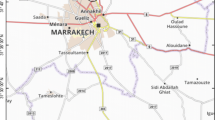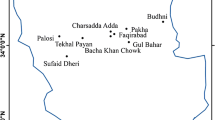Abstract
Vegetable fields in and around urban areas in the Kurdistan region of Iraq may have higher than background concentrations of potentially toxic elements (PTEs) from contamination sources including municipal waste disposal and wastewater used for irrigation. The purpose of this study was to assess PTE concentrations in soils and the edible parts of field-grown vegetables to quantify potential health risks to the local population. In this survey, 174 soils and 26 different vegetable and fruit types were sampled from 15 areas around Sulaymaniyah and Halabja cities. Sampling was undertaken from fields in urban, peri-urban and rural locations including sites close to areas of waste disposal. The soils are calcareous (pH 7.67–8.21) and classified as silty loam, sandy or silty clay with organic matter content between 6.62 and 11.4%. Concentrations of PTEs were typically higher in waste disposal areas compared with urban, peri-urban and rural areas. Pollution load indices suggested that agricultural soils near waste disposal sites were contaminated with some trace elements. Potentially toxic element concentrations in vegetables were highly variable. Higher total concentrations of PTEs were measured in vegetables from the waste areas with decreasing concentrations in urban, peri-urban and rural areas. Risks to human health were assessed using hazard quotients (HQ). Vegetable consumption poses no risk for adults, whereas children might be exposed to Ni, As and Cd. Although HQs suggest elevated risk for children from consumption of some vegetables, these risks are likely to be lower when realistic dietary consumption levels are considered.








Similar content being viewed by others
Change history
16 February 2021
A Correction to this paper has been published: https://doi.org/10.1007/s10653-021-00851-z
References
Ali, M. H. H., & Al-Qahtani, K. M. (2012). Assessment of some heavy metals in vegetables, cereals and fruits in Saudi Arabian markets. The Egyptian Journal of Aquatic Research, 38, 31–37.
Alloway, B. J. (2004). Contamination of soils in domestic gardens and allotments: A brief review. Land Contamination and Reclamation, 12, 179–187.
Ayers, R. (1994). Water quality for agriculture. In R. S. Ayers, & D. W. Westcot. Rome: Food and Agriculture Organization of the United Nations, 1976.
Clark, H., Brabander, D., & Erdil, R. (2006). Sources, sinks, and exposure pathways of lead in urban garden soil. Journal of Environmental Quality, 35, 2066–2074.
Elbagermi, M. A., Edwards, H. G. M., & Alajtal, A. I. (2013). Monitoring of heavy metal content in fruits and vegetables collected from production and market sites in the Misurata area of Libya. ISRN Analytical Chemistry, 2013, 1–5.
Environment Agency. (2009a). Updated technical background to the CLEA model. Science Report SC050021/SR3, Bristol.
Environment Agency. (2009b). Using soil guideline values. Science Report SC050021/SGV, Bristol.
European Commission. (2004). Commission Regulation (EC) No 466/2001 of 8 March 2001. Setting maximum levels for certain contaminants in foodstuffs. Consolidated text, CONSLEG: 2001R0466 -05/05/2004.
European Union. (2006). Commission regulation (EC) No.1881/2006 of 19 December 2006 setting maximum levels for certain contaminants in food stuff. Journal of European Union, L364.
FAO/WHO. (2001). Food additives and contaminants-joint FAO/WHO Food standards programme. ALINORM, 01(12A), 1–289.
Gebrekidan, A., Weldegebriel, Y., Hadera, A., & Van der Bruggen, B. (2013). Toxicological assessment of heavy metals accumulated in vegetables and fruits grown in Ginfel river near Sheba Tannery, Tigray, Northern Ethiopia. Ecotoxicology and Environmental Safety, 95, 171–178.
Gupt, N., Yadav, K. K., Kumar, V., Kumar, S., Chadd, R. P., & Kumar, A. (2019). Trace elements in soil–vegetables interface: Translocation, bioaccumulation, toxicity and amelioration—A review. Science of the Total Environment, 651, 2927–2942.
Habib, R. H., Salih, M. A., & Muhanad, Z. M. (2012). Toxic heavy metals in soil and some plants in Baghdad, Iraq. Journal Al-Nahrain University, 15, 1–16.
Hamad, S. H., Schauer, J. J., Shafer, M. M., Al-Rheem, E. A., Skaar, P. S., Heo, J., et al. (2014). Risk assessment of total and bioavailable potentially toxic elements (PTEs) in urban soils of Baghdad–Iraq. Science of the Total Environment, 494, 39–48.
Iqbal, J., & Shah, M. H. (2011). Distribution, correlation and risk assessment of selected metals in urban soils from Islamabad, Pakistan. Journal of Hazardous Materials, 192, 887–898.
Itanna, F. (2002). Metals in leafy vegetables grown in Addis Ababa and toxicological implications. Ethiopian Journal of Health Development, 16, 295–302.
Itoh, H., Iwasaki, M., Sawada, N., Takachi, R., Kasuga, Y., Yokoyama, S., et al. (2014). Dietary cadmium intake and breast cancer risk in Japanese women: A case–control study. International Journal of Hygiene and Environmental Health, 217, 70–77.
Jorfi, S., Maleki, R., Jaafarzadeh, N., & Ahmadi, M. (2017). Pollution load index for heavy metals in Mian-Ab plain soil, Khuzestan, Iran. Data in Brief, 15, 584–590.
Joy, E. J. M., Broadley, M. R., Young, S. D., Black, C. R., Chilimba, A. D. C., Ander, E. L., et al. (2015). Soil type influences crop mineral composition in Malawi. Science of the Total Environment, 505, 587–595.
Kabata-Pendias, A., & Mukherjee, A. B. (2007). Trace elements from soil to humans. Berlin: Springer.
Kumar, S. (2013). Appraisal of heavy metal concentration in selected vegetables exposed to different degrees of pollution in Agra, India. Environmental Monitoring and Assessment, 185, 2683–2690.
Lin, H.-J., Sung, T.-I., Chen, C.-Y., & Guo, H.-R. (2013). Arsenic levels in drinking water and mortality of liver cancer in Taiwan. Journal of Hazardous Materials, 262, 1132–1138.
Liu, X., Song, Q., Tang, Y., Li, W., Xu, J., Wu, J., et al. (2013). Human health risk assessment of heavy metals in soil–vegetable system: A multi-medium analysis. Science of the Total Environment, 463–464, 530–540.
MAFF. (1998). Code of good agriculture practice for the protection of soil. Ministry of Agriculture, Fisheries and Food. Welsh Office.
Möller, A., Müller, H. W., Abdullah, A., Abdelgawad, G., & Utermann, J. (2005). Urban soil pollution in Damascus, Syria: Concentrations and patterns of heavy metals in the soils of the Damascus Ghouta. Geoderma, 124, 63–71.
Mwesigye, A. R., Young, S. D., Bailey, E. H., & Balaba, T. S. (2016). Population exposure to trace elements from the Kilembe copper mine and tailing sites in Western Uganda: A pilot study. Science of the Total Environment, 573, 366–375.
Nabulo, G., Young, S. D., & Black, C. R. (2010). Assessing risk to human health from tropical leafy vegetables grown on contaminated urban soils. Science of the Total Environment, 408, 5338–5351.
Nazemi, S. (2012). Concentration of heavy metal in edible vegetables widely consumed in Shahroud, the North East of Iran. Journal of Applied Environmental and Biological Sciences, 2, 384–391.
Nazif, W., Marzouk, E. R., Perveen, S., Crout, N. M. J., & Young, S. D. (2015). Zinc solubility and fractionation in cultivated calcareous soils irrigated with wastewater. Science of the Total Environment, 518–519, 310–319.
Qadir, M., Ghafoor, A., Murtaza, G., & Murtaza, G. (2000). Cadmium concentration in vegetables grown on urban soils irrigated with untreated municipal sewage. Environment, Development and Sustainability, 2, 13–21.
Rashid, K. A. (2010). Environmental implication of Tanjaro waste disposal site in the city of Sulaymaniyah. PhD: University of Sulaymaniyah.
Rattan, R. K., Datta, S. P., Chhonkar, P. K., Suribabu, K., & Singh, A. K. (2005). Long-term impact of irrigation with sewage effluents on heavy metal content in soils, crops and groundwater—A case study. Agriculture, Ecosystems & Environment, 109, 310–322.
Säumel, I., Kotsyuk, I., Hölscher, M., Lenkereit, C., Weber, F., & Kowarik, I. (2012). How healthy is urban horticulture in high traffic areas? Trace metal concentrations in vegetable crops from plantings within inner city neighbourhoods in Berlin, Germany. Environmental Pollution, 165, 124–132.
Sharma, R. K., Agrawal, M., & Marshall, F. M. (2008). Heavy metal (Cu, Zn, Cd and Pb) contamination of vegetables in urban India: A case study in Varanasi. Environmental Pollution, 154, 254–263.
UK Food Standards Agency. (2009). Measurement of the concentrations of metals and other elements from the 2006 UK total diet study (pp. 1–45). Food survey information sheet 01/09. London: Food Standards Agency.
US EPA IRIS Database. (2009). United States environmental protection agency. Available at: http://www.epa.gov/iris.
USEPA. (2000). Risk-based concentration table. Philadelphia: United States Environmental Protection Agency.
Wang, H.-S., Zhao, Y.-G., Man, Y.-B., Wong, C. K. C., & Wong, M.-H. (2011). Oral bioaccessibility and human risk assessment of organochlorine pesticides (OCPs) via fish consumption, using an in vitro gastrointestinal model. Food Chemistry, 127, 1673–1679.
WHO. (1982). Toxicological evaluation of certain food additives, joint FAO/WHO expert committee on food additives. WHO Food Additive Series, No. 683. Geneva: World Health Organizaion.
Xu, D., Zhou, P., Zhan, J., Gao, Y., Dou, C., & Sun, Q. (2013). Assessment of trace metal bioavailability in garden soils and health risks via consumption of vegetables in the vicinity of Tongling mining area, China. Ecotoxicology and Environmental Safety, 90, 103–111.
Xu, J., Wu, L., Chang, A. C., & Zhang, Y. (2010). i. Impact of long-term reclaimed wastewater irrigation on agricultural soils: A preliminary assessment. Journal of Hazardous Materials, 183, 780–786.
Yang, Y., Zhang, F.-S., Li, H.-F., & Jiang, R.-F. (2009). Accumulation of cadmium in the edible parts of six vegetable species grown in Cd-contaminated soils. Journal of Environmental Management, 90, 1117–1122.
Zhao, Q., Wang, Y., Cao, Y., Chen, A., Ren, M., Ge, Y., et al. (2014). Potential health risks of heavy metals in cultivated topsoil and grain, including correlations with human primary liver, lung and gastric cancer, in Anhui province, Eastern China. Science of the Total Environment, 470–471, 340–347.
Author information
Authors and Affiliations
Corresponding author
Additional information
Publisher's Note
Springer Nature remains neutral with regard to jurisdictional claims in published maps and institutional affiliations.
Electronic supplementary material
Below is the link to the electronic supplementary material.
Rights and permissions
About this article
Cite this article
Hawrami, K.A.M., Crout, N.M.J., Shaw, G. et al. Assessment of potentially toxic elements in vegetables cultivated in urban and peri-urban sites in the Kurdistan region of Iraq and implications for human health. Environ Geochem Health 42, 1359–1385 (2020). https://doi.org/10.1007/s10653-019-00426-z
Received:
Accepted:
Published:
Issue Date:
DOI: https://doi.org/10.1007/s10653-019-00426-z




